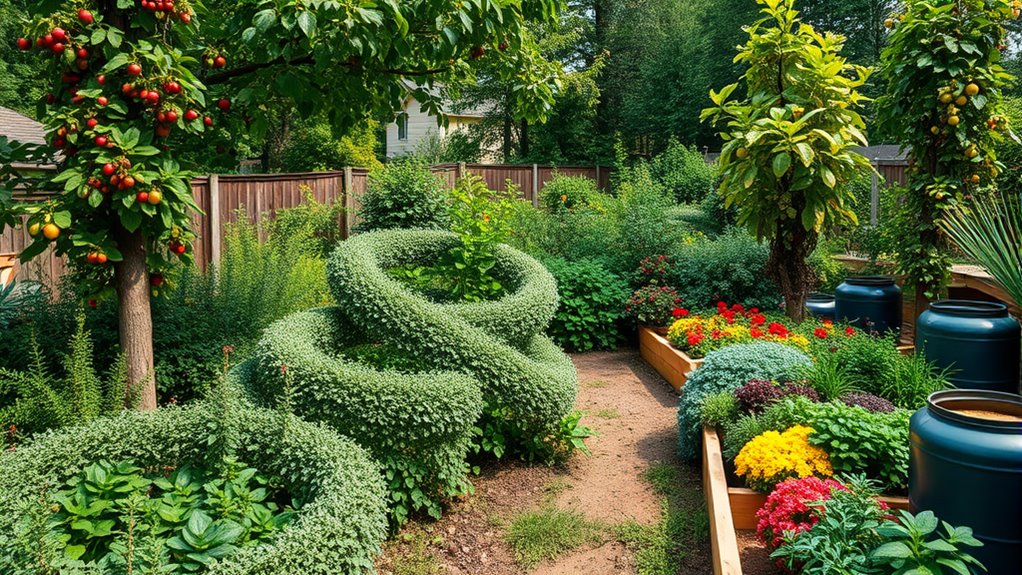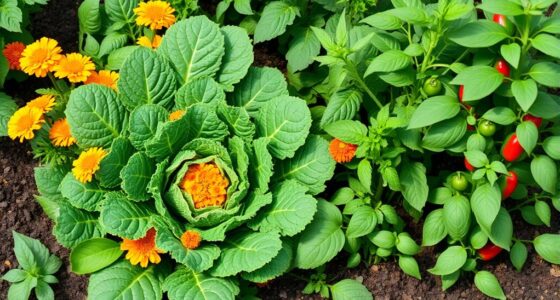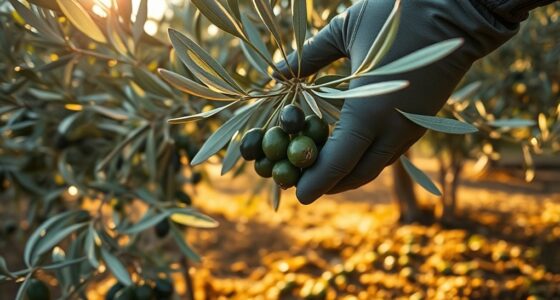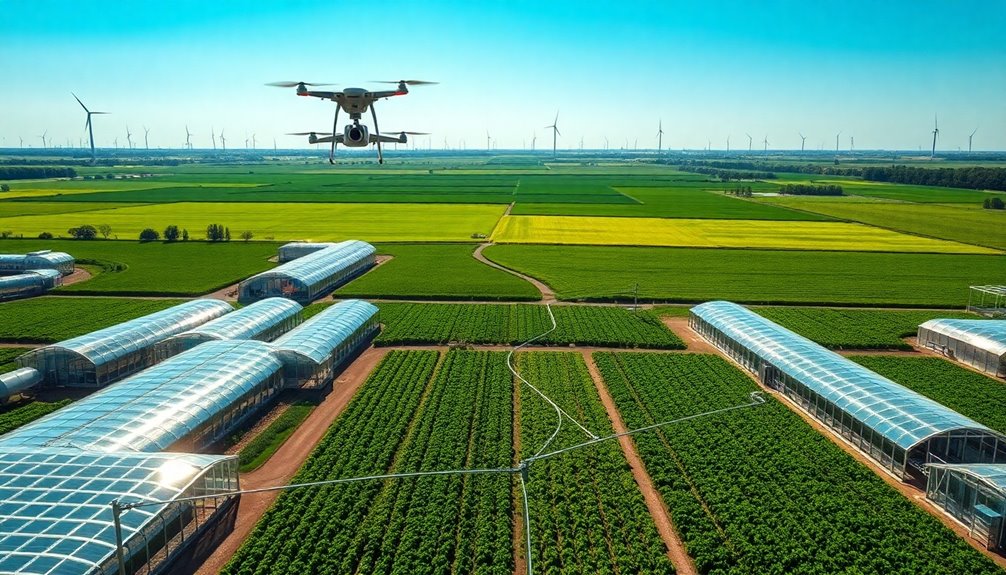Permaculture gardening for homesteaders involves mimicking natural ecosystems to create sustainable, low-maintenance landscapes. You’ll integrate companion planting to boost plant health and reduce pests naturally. Using water harvesting techniques, like rain barrels and swales, helps conserve moisture and build drought resilience. Mulching and composting enrich your soil while minimizing evaporation. Combining these practices creates resilient, productive gardens that work with nature. Keep exploring to discover how these methods integrate for a truly thriving homestead.
Key Takeaways
- Mimic natural ecosystems by integrating diverse plants and layers for resilience and sustainability.
- Use companion planting to enhance growth, control pests, and improve soil health naturally.
- Implement water harvesting techniques like rain barrels and swales to conserve water and reduce runoff.
- Mulch and compost to enrich soil, retain moisture, and reduce the need for chemical inputs.
- Combine water management and plant pairing practices to create low-maintenance, self-sustaining garden systems.
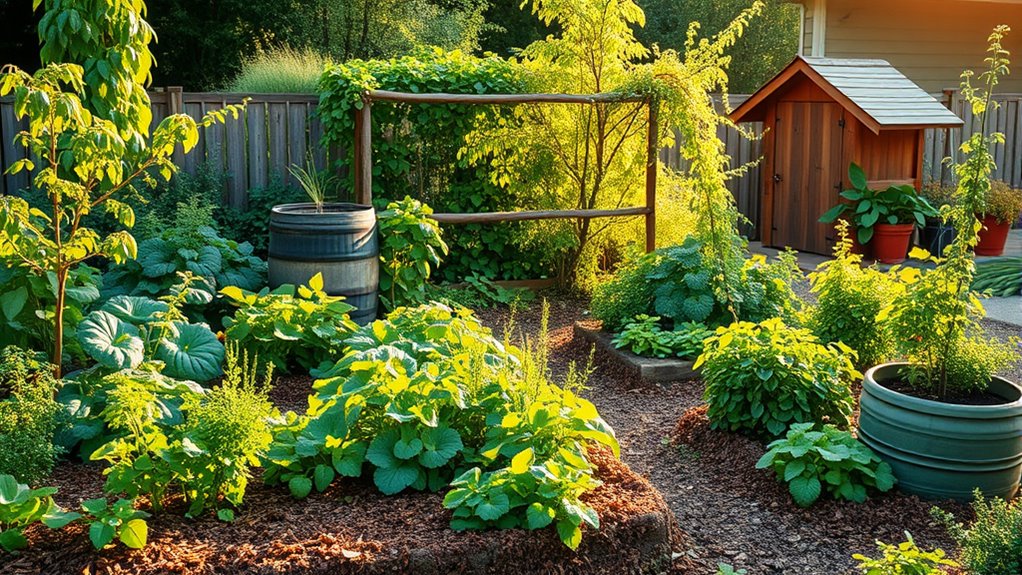
Permaculture gardening is a sustainable approach that mimics natural ecosystems to create productive and resilient outdoor spaces. When you design your garden with permaculture principles, you’re not just growing plants — you’re building a balanced system that sustains itself over time. One of the fundamental techniques you’ll want to master is companion planting. This method involves pairing certain plants together to enhance growth, deter pests, and improve soil health. For example, planting beans near corn can provide natural nitrogen fixation, boosting the nutrients available for both crops. Similarly, marigolds can be interspersed among vegetables to repel pests like nematodes and aphids. Companion planting reduces your reliance on chemical inputs and encourages a healthier, more diverse garden ecosystem. By understanding which plants support each other, you can optimize space and increase yields, making your garden more efficient and resilient.
Water harvesting is another essential aspect of permaculture gardening. Instead of relying solely on municipal water or well systems, you capture and store rainwater to sustain your plants during dry periods. Installing rain barrels or creating swales — shallow trenches that direct water to your garden beds — helps maximize your water collection. When you harvest water effectively, you create a self-sufficient system that reduces runoff and erosion while ensuring your plants stay hydrated. This approach not only conserves water but also improves soil moisture, supporting healthy root development and nutrient uptake. Incorporating mulch around your plants further enhances water retention, reducing evaporation and maintaining consistent moisture levels. Using water harvesting techniques can significantly increase your garden’s resilience to drought and unpredictable weather. Additionally, utilizing energy-efficient systems like solar-powered pumps can further optimize water management and reduce your environmental impact. Employing soil enrichment methods such as composting can also boost overall soil health and plant productivity. Moreover, understanding the importance of water conservation helps you develop more sustainable gardening practices.
As you implement these principles, you’ll notice how companion planting and water harvesting work hand-in-hand to create a more sustainable and low-maintenance garden. Companion planting naturally reduces pest issues and enhances plant health, while water harvesting ensures your garden receives the moisture it needs without excessive effort or resource use. Together, these practices embody the core of permaculture: working with nature rather than against it. You’ll find that your garden becomes more than just a place to grow food — it turns into a thriving, self-sustaining system that aligns with your desire for a resilient homestead. By adopting these techniques, you’re not only growing healthy food but also contributing to a healthier environment and a more sustainable way of living.
Frequently Asked Questions
How Do I Start a Permaculture Garden With Limited Space?
You can start a permaculture garden in limited space by focusing on vertical gardening and container planting. Use wall-mounted planters or stacked containers to maximize vertical space, making room for diverse plants. Choose multi-purpose containers that hold soil and water efficiently. Incorporate companion planting techniques to boost productivity. This approach helps you create a sustainable, productive garden even in small areas, making the most of every inch of your available space.
What Are the Best Native Plants for Permaculture in My Region?
You’re asking about native plants for your region, but remember, embracing regional biodiversity creates a resilient garden. Start by researching native flora, which naturally thrives and supports local ecosystems. These plants require less water and care, making your permaculture efforts sustainable. In your region, consider species that attract pollinators and provide food or habitat, ensuring your garden benefits both your homestead and the environment.
How Can I Incorporate Animals Into My Permaculture Design?
To incorporate animals into your permaculture design, focus on animal integration by choosing species that complement your system, like chickens for pest control or goats for brush clearing. Use composting strategies that include manure to enrich your soil naturally. Guarantee animals have access to shelter and water, and rotate them strategically to prevent overgrazing. This approach strengthens your ecosystem while providing fresh produce and natural fertilization.
What Are Common Pest Management Strategies in Permaculture?
Did you know that natural predators can reduce pest populations by up to 90%? In permaculture, you manage pests by encouraging beneficial insects like ladybugs and predatory beetles. You also practice crop rotation to prevent pest buildup and disrupt their lifecycle. These strategies work together, minimizing chemical use and creating a resilient, healthy ecosystem where pests are naturally kept in check, promoting sustainable gardening.
How Do I Maintain Soil Fertility Sustainably Over Time?
To maintain soil fertility sustainably, you should use composting techniques regularly to add organic matter and nutrients. Incorporate crop rotation to prevent soil depletion and break pest cycles. Mulch around plants to retain moisture and improve soil structure. Avoid synthetic fertilizers, and instead, focus on natural amendments like compost and cover crops. These practices keep your soil healthy, productive, and resilient over time, supporting a thriving garden.
Conclusion
Remember, a garden is a mirror of your patience and effort. By embracing permaculture principles, you create a sustainable, thriving space that benefits both you and the environment. Stay curious, adapt as you learn, and enjoy the journey of nurturing your homestead. As the saying goes, “The best time to plant a tree was 20 years ago; the second best time is now.” So get started today and watch your garden flourish.

